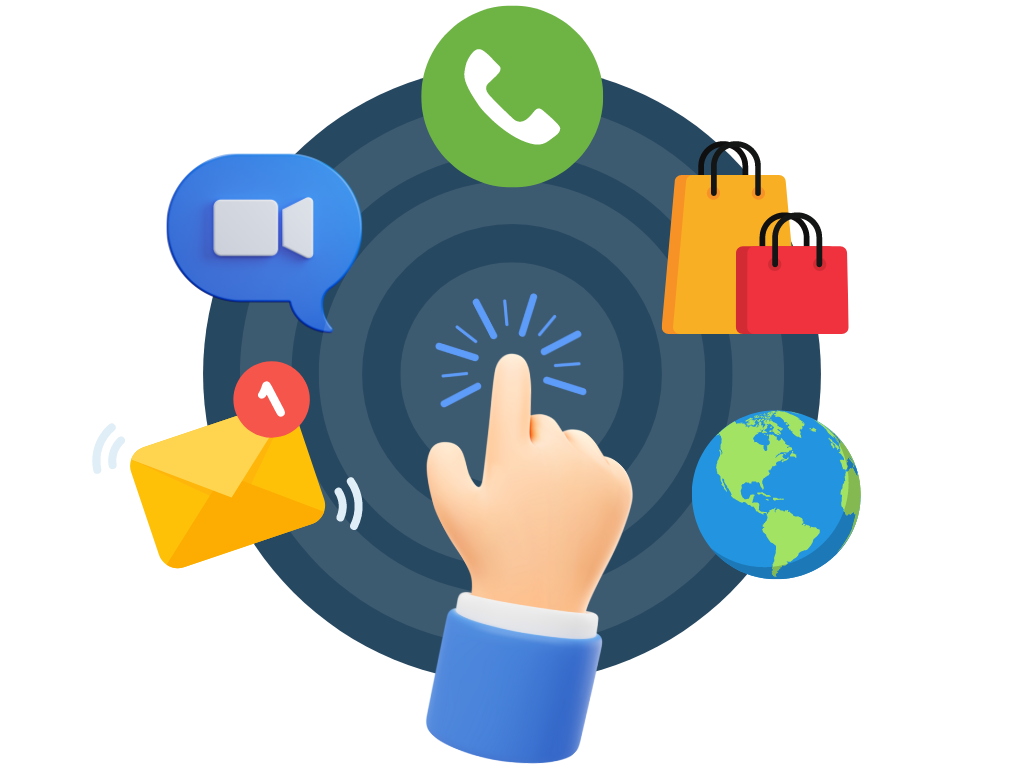In a competitive marketplace where prospective buyers are exposed to multiple providers, proactive touchpoints are crucial for businesses to gain customers’ trust and foster meaningful engagement.
You may have found this blog while researching something online or it might have been shared on one of our social channels. Just as you are searching online, your target audience and prospects are doing the same.
Interestingly, it’s not just one person searching online—often, it’s a committee. A recent study by Google suggests that while C-Suite executives have the final authority to sign off, various roles are involved in the buying decision. Some roles act as champions, while others serve as influencers. Therefore, it’s essential to understand your buying committee, their motivations, and needs, and to craft a cohesive, multi-touchpoint approach.

Microsoft’s Global State of Customer Service report reveals that 67% of respondents prefer proactive customer service notifications. This underscores the importance of building customer trust, with proactive engagement being a key factor.
The journey from customer acquisition to delivery and service can involve multiple steps. Therefore, the role of multi-touchpoints throughout the buyer journey has become more critical than ever, extending beyond pre-sales interactions to encompass the entire customer lifecycle.
Today’s B2B landscape presents challenges such as longer sales cycles and increased buyer scrutiny, making it essential to implement effective customer engagement strategies.
In this blog, we will guide you in integrating these strategies by discussing the different types of proactive touchpoints and how they can enhance your B2B sales engagement and conversion rates. Learn about the importance of timing, personalization, and the power of technology in implementing proactive touchpoints.
Understanding Proactive Touchpoints
Since the B2B buyer journey is more complex and involves a buying committee, a thorough understanding of customers’ buying motivation and decision-making is extremely helpful. This allows marketing teams to develop proactive touchpoints.
The touchpoint strategy is a business initiative to engage prospects and clients, successfully driving them through the B2B sales process. Reactive touchpoints, on the other hand, are a business’s response after a buyer has made their first move.
Their difference lies in the keyword “initiativeâ€, separating proactive touchpoint as a strategy that’s always one step ahead.
Statistics show that businesses employing proactive touchpoints see a significant impact in sales conversion rates and overall financial performance. For example, B2B companies that use personalized marketing in B2B strategies compared to those relying solely on reactive measures, according to Demand Gen report published in April of 2023.

Types of Proactive Touchpoints
Engaging your potential customers requires a well-planned approach that anticipates their needs and guides them through the decision-making process. In this section, we’ll delve into various proactive online and offline touchpoints and how to effectively integrate them into your B2B sales process.
Email Nurturing Sequences
Automated email sequences provide valuable content, answer FAQs, and clear the paths for prospects in finalizing a purchase decision. Segment your audience and personalize your messages so you can significantly enhance B2B customer engagement.
When planned properly and applied relevantly, these emails can become one of the most powerful media to nurture leads through the sales funnel.
Webinars and Virtual Events
Many B2B companies are hosting webinars and virtual events. Virtual events are a great way to showcase your expertise, build thought leadership, and generate trust in potential customers.
These events offer a platform for interactive discussions, allowing you to address specific pain points and demonstrate your solutions in real time. Webinars are particularly valuable when detailed information and personal engagement are needed during the lead nurturing phase.
 Personalized Demos and Product Walkthroughs
Offering personalized demos allows potential customers to see firsthand how your product or service can solve their problems. These sessions help them make informed decisions and influence them to be more intentional with their purchase.
When they see how you tailor your service to answer their specific needs, it will drastically improve engagement, making them more likely to move forward in the B2B sales process.
Â
Follow-Up Calls and Regular Check-Ins
Follow-up calls and regular check-ins reflect your willingness to offer top-quality services to clients. These touchpoints can open new opportunities, address concerns, reinforce the value of your offerings, and demonstrate your commitment to top-notch customer service.
Gifting: Another type of valuable touchpoint is gifting. By thanking potential customers for booking a discovery or giving you the time to share more information about a product or service, they will understand your level of seriousness and keep your company top of mind. Tools like Sendoso or Giftogram.com are excellent ways to effortlessly share your appreciation and guide potential customers further into the sales cycle.
Remarketing/ Retargeting Ads:- Display targeted ads to users who have previously interacted with your brand or website. By staying visible to interested potential customers, you increase the chances of conversion. These ads can be customized based on past interactions, ensuring relevance and boosting the likelihood of re-engagement.
Chatbot Interactions: Chatbots are automated tools that engage with users in real-time on your website or social media platforms. They enhance customer experience by offering immediate assistance and support. For instance, a chatbot might assist a prospect in scheduling a demo or provide detailed information about a product, making the decision-making process smoother.
Content Marketing: Blogs, whitepapers, and case studies are sources of high-quality content that can perpetually educate and engage your audience. Ensure your content aligns with your brand, especially to the needs of your target audience. Master the art of effective keyword research strategies, from SEO to leveraging third-party data sources.
Sharing valuable insights and solutions through content marketing helps establish your online authority and move customers through the sales funnel.

Timing and Relevance
Timing matters: Executing proactive touchpoints at the right moment in the sales cycle is critical to their effectiveness. To determine the best timing, analyze buyer behavior and identify key stages in the customer journey. For instance, following up with a personalized email immediately after a prospect downloads a whitepaper shows responsiveness and keeps the conversation going.
Relevance is equally important: Tailoring your touchpoints to address the specific needs and pain points of your prospects can significantly boost engagement and conversion rates. For example, a follow-up call that references a recent webinar they attended or a particular challenge they raised encourages higher engagement and trust.
Personalization and Context
Personalization is the core of effective proactive touchpoints.
Wearing the shoes of your buyer’s persona and looking into their industry, role, and specific challenges allows you to tailor more relevant and engaging interactions. Personalized touchpoints can include using the prospect’s name in emails to show they are a specific recipient of customized solutions, and not just part of batch newsletter. You can even send personalized gifts to valuable prospects, which shows your commitment to investing in their business. Personalization can also lead to higher trust, better experiences, and the chance of standing out in the overall decision-making process.
To personalize effectively, invest in research and gather data on your prospects and segment your audience accordingly. Use CRM systems and sales engagement platforms to track interactions and preferences.
This data-driven approach ensures that your touchpoints resonate with your target audience, providing your business with higher engagement and sales conversion rates.

Leveraging Technology for Proactive Engagement
Technology plays a crucial role in streamlining and optimizing proactive touchpoints.
AI and automation can help you manage and execute touchpoints more efficiently. For instance, marketing automation tools can schedule and send personalized email nurturing sequences, while AI-powered chatbots can engage prospects on your website in real-time.
CRM systems are powerful tools for tracking and managing touchpoints.
They provide a centralized view of all customer profiles, making it easier to cascade through every interaction and deliver timely and relevant touchpoints. Additionally, using sales engagement platforms can help you monitor the effectiveness of your touchpoints and adjust your strategies accordingly.
The Bottomline: Harnessing the Power of Proactive Touchpoints in B2B Sales
Proactive touchpoints are essential for driving engagement and conversions in B2B sales. By understanding the different types of touchpoints, their timing, and personalization, you can enhance your customer journey and sales funnel optimization.
Leverage technology in creating a robust B2B marketing strategy and ensure a more efficient and impactful B2B sales process.
Incorporate these proactive customer service strategies into your sales process to improve your B2B lead generation and overall sales performance. Remember, the key to successful B2B customer engagement lies in always being one step ahead.
Take the Next Step and Unlock Better B2B Sales Results Today!
Ready to enhance your B2B sales engagement, buyer experience, and conversion rates? Download our comprehensive checklist of effective touchpoints for each stage of the sales cycle.
Measure Marketing is equipped to give you personalized advice for your B2B journey. Schedule a consultation with us to discuss your proactive engagement strategy and start achieving better results today.